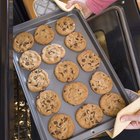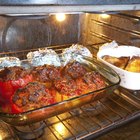
Jupiterimages/Stockbyte/Getty Images
Perfection may not be possible when baking cookies, but you can reduce the risk of uneven baking by checking both your equipment and your cooking techniques. If you want to impress your guests or win prizes at your county fair, select cookies with uniform size and color to serve on a tray. Otherwise, as you know, slight differences in the color of the cookies won't matter to those who eat and appreciate their homemade goodness.
Uneven Oven Temperatures
Not only do ovens vary in temperature from one kitchen to another, but the temperatures at different places within your oven also vary. Use an oven thermometer to test the temperatures on the right and left sides and the back and front of your oven, or place pieces of bread on a baking sheet and see which slices turn darker and lighter after 5 minutes of baking. When baking cookies, rotate the cookie sheet halfway through baking, moving the cookies at the back to the front.
One Pan at a Time
Placing two cookie sheets in your oven simultaneously saves baking time but results in uneven cooking -- the cookies on the higher rack typically have more air around them and brown more quickly than those underneath. You can rotate the baking sheets halfway through cooking, but this does not guarantee even baking. If rotating the sheets doesn't work in your oven, bake on just one sheet at a time so that heat, oven temperature and air distribution are the same for each batch.
Pans That Are Just Right
Evenly baked cookies cook on pans that are not too dark or too light and not too hot or too cold. Because dark-colored pans absorb more of your oven's infrared radiation, they brown cookies more quickly than do lighter-colored pans that reflect the heat. Unevenly baked cookies may result from cookie sheets of different colors. In addition, if you put the second batch of cookies on a hot baking sheet instead of waiting for it to cool slightly, the dough will spread out and brown more quickly than the first batch did once it is in the oven.
Watch the Dough
Your cooking-making techniques make a difference in how your cookies bake. Try to spread the cookie dough evenly in the pan, making cookies that are all the same size, and press the dough down slightly to further even out the cookies. Remove cookies from the baking sheets at the same time for each batch to ensure that some don't brown more on their undersides while sitting on a baking sheet.
Related Articles

How to Cook Cakes and Biscuits in a ...

How Does a Convection Oven Work?

How to Bake on Two Racks at Once

Does Heat Transfer Evenly Through ...

What Are the Benefits of Cooking With a ...

How to Keep Cupcake Wrappers From ...

What Is a Baking Wire Rack?

Do You Double the Time When Baking Two ...

How to Bake With a Pizza Screen
How to Cook in Tabletop Convection Ovens

How to Bake Cookies That Are Not Burnt ...

How to Cook Cinnamon Rolls in the ...

How Long Do You Bake Brownie Cupcakes ...
Can I Bake a Homemade Pizza on a Pan ...

How to Make Pizzelle Crisp in High ...

Does a Roaster Oven Cook Faster Than ...

Difference Between Baking on the Top & ...

Baking Vs. Roasting in Convection Ovens
Convection Broiling Vs. Convection ...

How Long and at What Temperature Do You ...
References
- Cooking Light: The Most Common Cooking Mistakes
- The Science of Good Cooking; Editors at America's Test Kitchen and Guy Crosby
- What Einstein Told His Cook 2; Robert L. Wolke
Writer Bio
Susan Lundman began writing about her love of cooking, ingredient choices, menu planning and healthy eating after working for 20 years on children's issues at a nonprofit organization. She has written about food online professionally for ten years on numerous websites, and has provided family and friends with homemade recipes and stories about culinary adventures. Lundman received her M.A. from Stanford University.
Photo Credits
Jupiterimages/Stockbyte/Getty Images